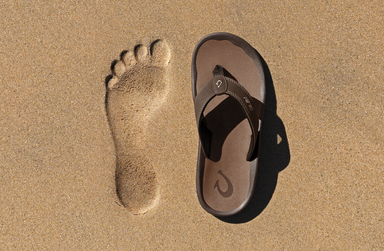Anywhere Aloha
OluKai
Nov 12, 2014
Into The Guardrails—the Extinction of Hawaii's Rail Birds
Birds embody boundless freedom, a creature capable of gliding on air stream currents toward new, foreign destinations. But a few avian species weren't so anatomically blessed—they couldn't fly from their presentable problems. And in the end, it became too much for two of Hawaii’s endemic birds—the Hawaii and Laysan rail. Here’s the story behind how they ran into the guardrails of sustainability.
The Birds of an Island's Past
[caption id="attachment_1463229" align="alignnone" width="600"]
 Laysan rail bird/Wikimedia
Laysan rail bird/Wikimedia[/caption]
The Laysan rail (
Porzana palmeri) is a flightless bird species, only endemic to the small island of Laysan. Laysan was not only home to this uniquely flightless bird, but the island represented a keystone habitat for migratory seabirds as well; it’s often be noted as one of the most important sea birding colonies in all of the United States. And not only were these dorsally brown colored rails flightless—they were also diminutive inside. Averaging no more than half-a-foot in length, Laysan rails were noted for scurrying about the island’s forest floors where they would feast on small to medium sized invertebrates, i.e. blow and brine flies.
[caption id="attachment_1463228" align="alignnone" width="600"]
 Hawaiian rail bird/Wikimedia
Hawaiian rail bird/Wikimedia[/caption]
Hawaii’s state-named rail, the Hawaii rail (
Porzana sandwichensis) was once found on the “Big Island,” as opposed to being endemically found on a smaller off-shore island. And being that there were distinctly different morphological populations, speculation arouse that the Hawaii rail wasn't just a single species—it quite possibly may have contained three genetically distinct populations. Between the different color mutations that have been documented and the sizable variations of “same-“species populations, it’s likely that factoid would've held-up, had these birds not later became extinct. Like their smaller kin, Hawaii rails occupied the same habitat niche as Laysan rails; they were, first and foremost, small insectivorous birds that resided on the forest floor.
Off the lane and into the guard rails
In a world where man’s ever-present shadow looms over every biotic being, it’s an all too common consequence of living in the ecology name “anthropocene era,” the age of human facilitated extinction. And unfortunately, the rail birds of Hawaii didn't fair too well. And it was myriad human footprints that lead to their descent into extinction’s heavily-occupied past. Both species of now-extinct rail birds were brought to extinction's knee-caps by one of our darkest practices—the introduction of alien species. Because of the near presence of food competition and high-tiered predators, feral dogs and established populations of European rats were most to blame for the extinction of the Hawaii and Laysan rail birds.
As with any great tragedy, there’s a lesson to be taken away. And that lesson, in this context, couldn’t be clearer—the establishments of invasive species often come at the cost of the endemically found ones. Be mindful of where you keep your animals, never shying away from housing them indoors. Be mindful, we live in a shared world. And some animals can’t simply fly far away from our mistakes.
 Laysan rail bird/Wikimedia[/caption]
The Laysan rail (Porzana palmeri) is a flightless bird species, only endemic to the small island of Laysan. Laysan was not only home to this uniquely flightless bird, but the island represented a keystone habitat for migratory seabirds as well; it’s often be noted as one of the most important sea birding colonies in all of the United States. And not only were these dorsally brown colored rails flightless—they were also diminutive inside. Averaging no more than half-a-foot in length, Laysan rails were noted for scurrying about the island’s forest floors where they would feast on small to medium sized invertebrates, i.e. blow and brine flies.
[caption id="attachment_1463228" align="alignnone" width="600"]
Laysan rail bird/Wikimedia[/caption]
The Laysan rail (Porzana palmeri) is a flightless bird species, only endemic to the small island of Laysan. Laysan was not only home to this uniquely flightless bird, but the island represented a keystone habitat for migratory seabirds as well; it’s often be noted as one of the most important sea birding colonies in all of the United States. And not only were these dorsally brown colored rails flightless—they were also diminutive inside. Averaging no more than half-a-foot in length, Laysan rails were noted for scurrying about the island’s forest floors where they would feast on small to medium sized invertebrates, i.e. blow and brine flies.
[caption id="attachment_1463228" align="alignnone" width="600"] Hawaiian rail bird/Wikimedia[/caption]
Hawaii’s state-named rail, the Hawaii rail (Porzana sandwichensis) was once found on the “Big Island,” as opposed to being endemically found on a smaller off-shore island. And being that there were distinctly different morphological populations, speculation arouse that the Hawaii rail wasn't just a single species—it quite possibly may have contained three genetically distinct populations. Between the different color mutations that have been documented and the sizable variations of “same-“species populations, it’s likely that factoid would've held-up, had these birds not later became extinct. Like their smaller kin, Hawaii rails occupied the same habitat niche as Laysan rails; they were, first and foremost, small insectivorous birds that resided on the forest floor.
Off the lane and into the guard rails
In a world where man’s ever-present shadow looms over every biotic being, it’s an all too common consequence of living in the ecology name “anthropocene era,” the age of human facilitated extinction. And unfortunately, the rail birds of Hawaii didn't fair too well. And it was myriad human footprints that lead to their descent into extinction’s heavily-occupied past. Both species of now-extinct rail birds were brought to extinction's knee-caps by one of our darkest practices—the introduction of alien species. Because of the near presence of food competition and high-tiered predators, feral dogs and established populations of European rats were most to blame for the extinction of the Hawaii and Laysan rail birds.
As with any great tragedy, there’s a lesson to be taken away. And that lesson, in this context, couldn’t be clearer—the establishments of invasive species often come at the cost of the endemically found ones. Be mindful of where you keep your animals, never shying away from housing them indoors. Be mindful, we live in a shared world. And some animals can’t simply fly far away from our mistakes.
Hawaiian rail bird/Wikimedia[/caption]
Hawaii’s state-named rail, the Hawaii rail (Porzana sandwichensis) was once found on the “Big Island,” as opposed to being endemically found on a smaller off-shore island. And being that there were distinctly different morphological populations, speculation arouse that the Hawaii rail wasn't just a single species—it quite possibly may have contained three genetically distinct populations. Between the different color mutations that have been documented and the sizable variations of “same-“species populations, it’s likely that factoid would've held-up, had these birds not later became extinct. Like their smaller kin, Hawaii rails occupied the same habitat niche as Laysan rails; they were, first and foremost, small insectivorous birds that resided on the forest floor.
Off the lane and into the guard rails
In a world where man’s ever-present shadow looms over every biotic being, it’s an all too common consequence of living in the ecology name “anthropocene era,” the age of human facilitated extinction. And unfortunately, the rail birds of Hawaii didn't fair too well. And it was myriad human footprints that lead to their descent into extinction’s heavily-occupied past. Both species of now-extinct rail birds were brought to extinction's knee-caps by one of our darkest practices—the introduction of alien species. Because of the near presence of food competition and high-tiered predators, feral dogs and established populations of European rats were most to blame for the extinction of the Hawaii and Laysan rail birds.
As with any great tragedy, there’s a lesson to be taken away. And that lesson, in this context, couldn’t be clearer—the establishments of invasive species often come at the cost of the endemically found ones. Be mindful of where you keep your animals, never shying away from housing them indoors. Be mindful, we live in a shared world. And some animals can’t simply fly far away from our mistakes.





